Web Accessibility Best Practices: Building Inclusive Digital Experiences

Web accessibility is about ensuring that websites and web applications are designed and developed so that people with disabilities can use them. This includes individuals with visual, auditory, physical, speech, cognitive, and neurological disabilities. In this article, we'll explore the importance of web accessibility and share best practices for creating inclusive digital experiences.
Why Web Accessibility Matters
Web accessibility is not just a nice-to-have feature; it's a necessity for several compelling reasons:
Ethical Considerations
The web is a fundamental resource in many aspects of life, including education, employment, government, commerce, healthcare, and recreation. Ensuring equal access to these resources is a matter of basic human rights and dignity.
Legal Requirements
Many countries have laws and regulations that require digital accessibility. For example, in the United States, the Americans with Disabilities Act (ADA) and Section 508 of the Rehabilitation Act mandate accessibility for certain websites. The European Union has the European Accessibility Act, and many other countries have similar legislation.
Business Benefits
Accessible websites reach a wider audience, improve SEO, demonstrate corporate social responsibility, drive innovation, and minimize legal risk. According to the World Health Organization, about 15% of the world's population lives with some form of disability—that's over a billion potential customers.
Web Content Accessibility Guidelines (WCAG)
The Web Content Accessibility Guidelines (WCAG) are developed by the World Wide Web Consortium (W3C) and provide a set of recommendations for making web content more accessible. WCAG is organized around four principles, often referred to as POUR:
Perceivable
Information and user interface components must be presentable to users in ways they can perceive. This means providing text alternatives for non-text content, captions for multimedia, creating content that can be presented in different ways, and making it easier for users to see and hear content.
Operable
User interface components and navigation must be operable. This includes making all functionality available from a keyboard, giving users enough time to read and use content, not designing content in a way that is known to cause seizures, and providing ways to help users navigate and find content.
Understandable
Information and the operation of the user interface must be understandable. This means making text readable and understandable, making web pages appear and operate in predictable ways, and helping users avoid and correct mistakes.
Robust
Content must be robust enough that it can be interpreted reliably by a wide variety of user agents, including assistive technologies. This involves maximizing compatibility with current and future user tools.
Practical Accessibility Tips
Semantic HTML
Use semantic HTML elements that clearly describe their meaning in a human- and machine-readable way. For example, use <header>, <nav>, <main>, <article>, <section>, <aside>, and <footer> instead of generic <div> elements.
Alternative Text for Images
Provide alternative text for images that conveys the same information or function as the image. This allows screen readers to describe the image to users who cannot see it.
<img src="chart.png" alt="Bar chart showing sales growth of 25% in Q1 2023" />Keyboard Navigation
Ensure that all interactive elements are accessible via keyboard navigation. Users should be able to tab through interactive elements in a logical order, and the current focus should be visually apparent.
Color Contrast
Maintain sufficient color contrast between text and its background. WCAG 2.1 Level AA requires a contrast ratio of at least 4.5:1 for normal text and 3:1 for large text.
Form Labels and Instructions
Associate labels with form controls and provide clear instructions for form completion. Use the <label> element to associate labels with form controls programmatically.
<label for="name">Name:</label>
<input type="text" id="name" name="name" required />ARIA Attributes
Use ARIA (Accessible Rich Internet Applications) attributes when necessary to enhance accessibility, especially for dynamic content and custom widgets. However, native HTML elements with built-in accessibility features are preferable when available.
Descriptive Links
Make link text descriptive and meaningful out of context. Avoid generic phrases like "click here" or "read more."
Captions and Transcripts
Provide captions for videos and transcripts for audio content to make them accessible to users who are deaf or hard of hearing.
Responsive Design
Implement responsive design to ensure your website is usable across different devices and screen sizes. This benefits all users, including those with disabilities who may use specialized devices or zoom in on content.
Testing for Accessibility
Regular testing is essential to ensure your website meets accessibility standards. Here are some approaches to accessibility testing:
Automated Testing
Use automated tools like Axe, WAVE, or Lighthouse to identify common accessibility issues. These tools can quickly scan your website and provide reports on potential problems.
Manual Testing
Conduct manual tests using keyboard navigation, screen readers (like NVDA, JAWS, or VoiceOver), and other assistive technologies to experience your website as users with disabilities would.
User Testing
Involve people with disabilities in your testing process to get real-world feedback on the accessibility of your website.
Conclusion
Web accessibility is not just about compliance with guidelines and regulations; it's about creating inclusive digital experiences that everyone can use. By following the best practices outlined in this article, you can make your websites more accessible to all users, including those with disabilities.
Remember that accessibility is not a one-time effort but an ongoing process. As you add new content and features to your website, continue to prioritize accessibility to ensure that all users can benefit from what you have to offer.
By making web accessibility a priority, you're not only doing the right thing ethically and legally but also expanding your reach and improving the user experience for everyone.


